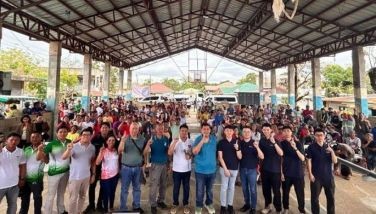Ride at your own risk

The roads leading to the University of the Philippines campus in Diliman used to be full of red JD buses.
There was no bus air conditioning back then. When it rained, bus riders pushed up wooden windows. In Quiapo and Sta. Cruz districts, open-sided buses could still be seen.
During rush hour the JD buses were as packed as today’s overhead railway trains during peak periods. The buses groaned from the weight of overloading and lumbered along like hippos with gout, their tailpipes emitting foul black smoke, but they reached their destinations in one piece.
The arrival of the “Love Bus†revolutionized the industry. Imelda Marcos, the other half of the conjugal dictatorship, saw the need to keep out the tropical heat and pollution from the hoi polloi’s daily commute. She introduced the sleek air-conditioned bus, painted blue, with no standing on the aisle allowed.
Imeldific, despite her proclivity for tacky excess, was one of the first global Pinoys, probably because she got to see the world extensively (on taxpayers’ money). She knew life was better in other countries and imported some of the ideas and projects for Pinoys (pocketing, it is believed, huge commissions in the process).
It’s not clear why her bus project was called the Love Bus. I guess people thought an air-conditioned ride was conducive to amorous activities.
The first Love Bus terminal was in Escolta, the Ayala Avenue of that period. The bus passed through Quezon Avenue and then around the UP campus before turning back to Manila.
Today all the wood-bodied buses are gone. Air-conditioned buses are ubiquitous, with many featuring TV shows and wi-fi. Buses with no air conditioning, however, are still around and quite popular because the fares are cheaper.
Standing room is allowed on most of the buses, air-conditioned or not. The reason for this is the same reason why buses stop wherever they please, any time, to pick up passengers, and linger for a long time at each designated stop, turning many spots into their terminals: drivers are paid according to the number of passengers they pick up, or they are given incentives for packing each bus with as many passengers as possible.
Once the bus is packed to the hilt, the driver then races like a madman to make as many trips as possible during his work period. Many drivers work overtime for extra pay, which can be dangerous for road safety.
Combined with traffic mismanagement and poor law enforcement, the result is chaos in the streets of Metro Manila, and one of the world’s most inefficient – and dangerous – mass transportation systems.
* * *
That horrific accident on the Skyway can only further dampen public enthusiasm to switch from using private cars to mass transportation.
Maybe some civil engineering experts are correct in pointing out that the Skyway is built for accidents. But professional drivers – which bus drivers are supposed to be – should have enough sense to slow down when it rains. Among the first rules new drivers learn is that pavement gets slippery when wet, and smooth pavement such as the one on the Skyway is particularly slippery.
Traction becomes a serious problem on rainy days when bus owners scrimp on maintenance, risking defective brakes and allowing their buses to run on bald tires.
Using worn tires – also a common practice among jeepney operators and truck hauling firms – means frequent blowouts, often in the middle of busy streets, causing traffic jams.
Skyway video footage showed the Don Mariano bus swerving, as if it had skidded, and then hitting the railing and flipping over as it plummeted to the West Service Road in Parañaque, where it squashed a luckless passing van.
Private car owners are aware that the simplest answer to Metro Manila’s traffic problem is to have fewer vehicles on the road.
Before private car owners switch to commuting, however, they need to see an efficient mass transportation system in place – one that is swift, clean, comfortable, affordable, and relatively safe from muggers and sexual molesters.
This is not asking too much; such mass transport systems, buses included, are common in many countries. Designated stops and schedules are strictly followed; no lingering is allowed at each stop.
In some of the world’s top urban tourist destinations, mass transport systems are the best ways to see the sights. Foreign visitors can easily take the bus or subway in Manhattan, Washington, Paris, London and Vienna.
You can tour almost the entire Singapore by riding the subway. Seoul has one of the most efficient subway systems. The Moscow subway is renowned. An expat friend now assigned in Paris, where he also spent his college years, is waiting for the chance to take me around the City of Lights by “BMW†– bus, Metro, walk.
In our case, the MRT and LRT are badly in need of expansion. No one is seriously considering building a subway in flood-prone Metro Manila. An efficient water pumping system can make a subway viable, but the operative word is efficient. One look at Manila’s Lagusnilad underpass, just across city hall, after an ordinary downpour and you’ll shudder at the thought of having a subway in the nation’s capital.
Taxis can be OK, but the latest MO of crooks can be scary: passengers are spritzed by the cabbie with a gas from the air-conditioning vent, which induces a nap. The passenger wakes up shortly with valuables gone and the cabbie saying don’t look at me.
As for the public bus, private car owners’ confidence in the safety of a bus ride plummeted along with that Don Mariano bus.
- Latest
- Trending






















